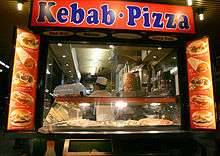Doner kebab
Doner kebab (also döner kebab) (UK: /ˈdɒnər kɪˈbæb/, US: /ˈdoʊnər kɪˈbɑːb/; Turkish: döner or döner kebap [dœˈneɾ keˈbap]) is a type of kebab, made of meat cooked on a vertical rotisserie.[1] Seasoned meat stacked in the shape of an inverted cone is turned slowly on the rotisserie, next to a vertical cooking element. The outer layer is sliced into thin shavings as it cooks. The vertical rotisserie was invented in the 19th-century Ottoman Empire, and doner kebab inspired similar dishes such as the Arab shawarma, Greek gyros, and Mexican al pastor.[2][3][4]
.jpg)
Doner meat being sliced from a rotating spit in Istanbul (2012) | |
| Course | Snack or main course |
|---|---|
| Place of origin | Ottoman Empire |
| Region or state | Anatolia (in present-day Turkey) |
| Serving temperature | Hot |
| Main ingredients | Lamb, beef, chicken, or (rarely) pork |
| Variations | İskender, Shawarma, Gyros, Al pastor |
The sliced meat of a doner kebab may be served on a plate with various accompaniments, stuffed into a pita or other type of bread as a sandwich, or wrapped in a thin flatbread such as lavash or yufka, known as a dürüm (literally meaning roll or wrap in Turkish). Since the early 1970s, the sandwich or wrap form has become popular around the world as a fast food dish sold by kebab shops, and is often called simply a "kebab". The sandwich generally contains salad or vegetables, which may include tomato, lettuce, cabbage, onion with sumac, fresh or pickled cucumber, or chili, and various types of sauces.
History
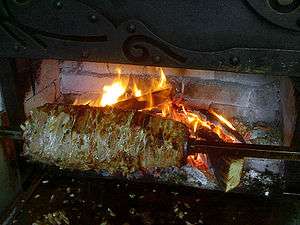
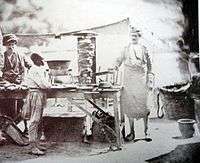
In the Ottoman Empire, at least as far back as the 17th century, stacks of seasoned sliced meat were cooked on a horizontal rotisserie, similar to the cağ kebab.[2] The vertical rotisserie was introduced no later than the mid-19th century.[2][4][5] The town of Bursa, in modern-day Turkey, is often considered the birthplace of the vertically roasted döner kebab.[6] According to Yavuz İskenderoğlu, his grandfather İskender Efendi as a child in 1850s Bursa had the idea of roasting the lamb at his father's restaurant vertically rather than horizontally; it was a success, and some years later became known as döner kebap.[7] However, he may have been preceded by Hamdi Usta from Kastamonu around 1830.[8][9][10]
An Arab version became known as shawarma. By at least the 1930s it had been brought overseas, and was sold in restaurants in Mexico by Lebanese immigrants.[11] Doner kebab likely arrived in Greece in the 1920s with the population exchange between Greece and Turkey, later transforming into gyros.[12]
It was not until a century after its invention that döner kebab was introduced and popularized in Istanbul, most famously by Beyti Güler. His restaurant, first opened in 1945, was soon discovered by journalists and began serving döner and other kebab dishes to kings, prime ministers, film stars and celebrities.[13] It has been sold in sandwich form in Istanbul since at least the mid-1960s.[10]
The döner kebab and its derivatives served in a sandwich form as "fast food" came to worldwide prominence in the mid to late 20th century. The first doner kebab shop in London opened in 1966[14] and they were a familiar sight in provincial cities by the late 1970s, while gyros was already popular in Greece and New York City in 1971.[15][16] A Greek-Canadian variation, the donair, was introduced in 1972, eventually becoming the official food of Halifax, and spreading across the country.[17][18] By the 1960s, the taco al pastor in Mexico had evolved from the shawarma.[11]
In Germany, the döner kebab was popularized by Turkish guest workers in Berlin in the early 1970s.[19] The dish developed there from its original form into a distinctive style of sandwich with abundant salad, vegetables, and sauces, sold in large portions at affordable prices, that would soon become one of the top-selling fast food and street food dishes in Germany and much of Europe, and popular around the world.[20]
Etymology
In the English name "doner kebab", the word doner is borrowed from the Turkish döner kebap, with the Turkish letter ö usually anglicized as "o",[21] though "döner kebab" is an alternative spelling in English.[22] The word "kebab" is used, which comes to English from the Arabic: كَبَاب (kabāb), partly through Urdu, Persian and Turkish; it may refer to a number of different kebab dishes made with roasted or grilled meat. While kebab has been used in English since the late 17th century, doner/döner kebab is known only from the mid-20th or later.[22] The Turkish word döner comes from dönmek ("to turn" or "to rotate"), so the Turkish name döner kebap literally means "rotating roast".[23] In German, it is spelled Döner Kebab, which can also be spelled Doener Kebab if the ö character is not available; the sandwich is often called ein Döner. Particularly in British English, a döner kebab sandwich may be referred to simply as "a kebab". A Canadian variation is "donair". In Greek, it was originally called döner (Greek: ντονέρ) but later came to be known as gyros, from γύρος ("turn"), a calque of the Turkish name.[24] The Arabic name شاورما (shāwarmā) derives from another Turkish word, çevirme, also meaning "turning". Persians refer to it as "kebab torki".[25]
Döner in Turkey
There are many variations of döner in Turkey:
- Porsiyon ("portion", döner on a slightly heated plate, sometimes with a few grilled peppers or broiled tomatoes on the side)
- Pilavüstü ("over rice", döner served on a base of pilaf rice)
- İskender (specialty of Bursa, served in an oblong plate, atop a base of pide (thin flatbread similar to pita), with a dash of pepper or tomato sauce and boiling fresh butter)[27] "Kebapçı İskender" is trademarked by Yavuz İskenderoğlu, whose family still runs the restaurant in Bursa.[28][29][30]
- Dürüm, wrapped in a thin lavaş that is sometimes also grilled after being rolled, to make it crispier. It has two main variants in mainland Turkey:
- Tombik or gobit (literally "the chubby", döner in a bun-shaped pita, with crispy crust and soft inside, and generally less meat than a dürüm)
- Ekmekarası ("between bread", generally the most filling version, consisting of a whole (or a half) regular Turkish bread filled with döner)
Regional variations
Caucasus, Middle East and Asia
Azerbaijan
In Azerbaijan, döner kebab (Azerbaijani: dönər), served similarly to the European style of sandwich wrapped in lavaş (flatbread) or in çörәk (bread, including tandoor bread), is one of the most widespread fast foods. It is usually made with әt (meat, essentially lamb or mutton), but sometimes toyuq (chicken).[31][32][33]
Japan
In Japan, döner kebabs are now common, especially in Tokyo. They are predominantly made of chicken but occasionally beef, and called simply "kebab". The toppings include shredded lettuce or cabbage, sliced tomato, and usually a choice of sauces such as Thousand Islands, spicy, and garlic.[34]
Vietnam
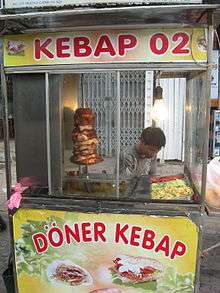
Döner kebab is increasingly becoming popular in Vietnam, mostly because of Vietnamese who used to live in Germany and introduced it to their homeland. Throughout Hanoi and Ho Chi Minh City many döner kebab stalls can be found. Bánh mỳ Döner Kebab, the Vietnamese version of the döner kebab, has some fundamental differences with the original döner kebab. First of all, pork is used instead of beef and lamb. Second, the meat is served in a Vietnamese baguette. Thirdly, the meat is topped with sour vegetables and chili sauce.[35][36]
Europe
Austria
Döner kebab shops can be found in all cities across Austria. Kebabs (often referred to as "Döner") outsell burgers or the traditional Würstel (sausage).[37]
Finland
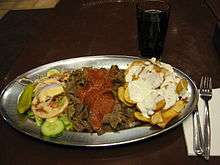
In Finland, döner kebabs have gained a lot of popularity since Turkish immigrants opened restaurants and imported their traditional food. Kebabs are generally regarded as fast food, often served in late-night restaurants also serving pizza, as well as shopping malls.[38] There are over 1,000 currently active restaurants that serve kebab foods[39] in Finland, making one kebab restaurant for every 5,000 people in mainland Finland.[40]
France
Turkish immigrants also brought doner kebab to France, where it became especially popular with the country's large North African population, in the 1980s.[41] A typical kebab consists of bread stuffed with döner meat shavings, lettuce, sliced tomato and onions, with a choice of sauce including sauce blanche, a mayo-yogurt sauce. Kebabs are usually served with french fries, often stuffed into the bread itself. In Paris, this variation is called Sandwich grec ("Greek sandwich").[42][43] Doner kebab is the third most popular fast food in France, next to hamburgers and pizza, with more than 10,000 kebab shops selling about 300 million a year.[41]
Germany
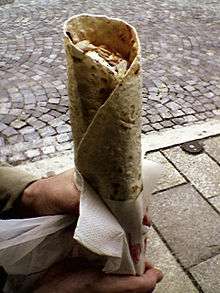
In Germany, the earliest claim to the introduction of Turkish döner kebab dates to 1969, when Bursa native Nevzat Salim and his father started to sell the Iskender Kebap in Reutlingen.[44] However, the Association of Turkish Döner Producers in Europe (ATDID) connects the wide popularization of the dish to the stand of Turkish guest worker Kadir Nurman at West Berlin's Zoo Station in 1972, which helped establish the döner kebab sandwich as a fast food option.[44][19] While the claims of multiple persons to have "invented" the döner may be hard to prove,[45] the further development of döner kebab is connected to the city of Berlin.
The döner kebap as it was first served in Berlin contained only meat, onions and a bit of salad.[46] Over time, it developed into a dish with abundant salad, vegetables, and a selection of sauces to choose from. Even orders placed in the Turkish language in Berlin will ask for the hot sauce using the German word "scharf", flagging the hybrid nature of the Berlin style of döner kebap.[47] This variation served with pita bread has influenced the style of döner kebap in Germany and in other nations. A 2007 survey showed that many people consider the döner kebab to be the most characteristic food of Berlin.[48]
Annual sales of döner kebabs in Germany amounted to €2.5 billion in 2010.[49] Beef or veal, and chicken, are widely used instead of the more expensive lamb. Turkey ("Truthahn") and vegetarian versions are becoming increasingly popular.
Tarkan Taşyumruk, president of the Association of Turkish Döner Producers in Europe (ATDID), provided information in 2010 that, every day, more than 400 tonnes of döner kebab meat is produced in Germany by around 350 firms. At the same ATDID fair, Taşyumruk stated that, "Annual sales in Germany amount to €2.5 billion. That shows we are one of the biggest fast-foods in Germany." In many cities throughout Germany, döner kebabs are at least as popular as hamburgers or sausages, especially with young people.[49]
In 2011 there were over 16,000 establishments selling döner kebabs in Germany, with yearly sales of €3.5 billion.[50]
Netherlands
Kapsalon is a Dutch food item consisting of French fries topped with döner or shawarma meat, garlic sauce, and a layer of Gouda cheese, baked or broiled until melted, and then subsequently covered with a layer of dressed salad greens and more sauce. The dish is usually served as fast food in a disposable metal tray. The term kapsalon means "hairdressing salon" or "barbershop" in Dutch, alluding to hairdresser Nathaniel Gomes who originated the dish when he requested his local kebab shop in Rotterdam to prepare it for him.[51]
United Kingdom
Introduced by Turkish immigrants, the döner kebab with salad and sauce is a very popular dish in the United Kingdom, especially after a night out.[45]
Americas
Canada
A variation known as donair was introduced in Halifax, Nova Scotia, in the early 1970s.[17] There are competing claims about the origin, but according to Halifax resident Leo Gamoulakos, his father, Greek immigrant Peter Gamoulakos, started selling Greek-style gyros at Velos Pizza in the Halifax suburb of Bedford. It did not catch on with the public, so in 1972[17] he modified the customary pork and lamb recipe by using spiced ground beef, Lebanese flatbread, and inventing the distinctive sweet donair sauce made with condensed milk, vinegar, sugar, and garlic. He called it by the doner name rather than gyros, but it came to be pronounced, and spelled, as donair.[52][53][54][55] In 1973 Gamoulakos opened the first King of Donair restaurant on Quinpool Road in Halifax.[56] In 2015, Halifax named donair the city's official food.[18] Historically found only in Atlantic Canada, the dish's popularity has expanded throughout Canada.[52]
Mexico
Al pastor is a variation of döner kebab via Lebanese shawarma. Literally "in the style of the shepherd", it references the lamb often used in shawarma, though it is normally made with pork.[57]
United States
Doner kebab is best known in the United States in its Greek variation, now known as gyros. Numerous people have made competing claims to have introduced the dish sometime in the 1960s, and its mass-production in the 1970s.[58] Originally known in Greece as ντονέρ (doner), by 1970 in the United States the newly coined name gyros was commonly in use,[59][60] though it was still known in some Greek restaurants by both names into the 1970s.[61][16] It was also available, possibly later, in some Turkish restaurants.[62][63][64] In recent years a number of restaurants and food trucks specializing in döner kebab have opened in various parts of the country; a substantial percentage are owned by German immigrants.[65] Verts Mediterranean Grill, an Austin-based döner kebab chain with locations mainly in Texas, has become the second-largest döner kebab chain in the world.[66][67]
Oceania
Australia
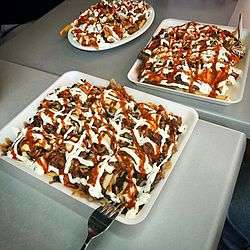
With a multicultural population, the doner kebab in Australia competes with the Greek gyros and the Lebanese shawarma.[68] Kebab sellers are subject to strict government food safety regulations.[69]
A halal snack pack is a dish that originated in Australia. It consists of halal-certified doner kebab meat, chips / french fries, and sauces such as chili, garlic and barbecue. It is traditionally served in a styrofoam container, and has been described as a staple dish of takeaway kebab shops in Australia.[70][71] The name of the dish was selected by the Macquarie Dictionary as the "People's choice Word of the Year" for 2016.[72]
Health concerns
Health concerns regarding döner kebab, including the hygiene involved in overnight storage and re-heating of partially cooked meat, its quality, as well as high salt, fat, and calorie levels, have been reported in the media.[73][74][75] Some investigations have found poor-quality ingredients in döner kebab meat, or meat types other than what was advertised.[76][77] Food safety regulations in most countries address the dangers of bacteria in undercooked meat of all kinds, sold to the public. Some have guidelines specific to döner kebab handling and preparation. Following several outbreaks of E. coli food poisoning, the Canadian government in 2008 introduced a number of recommendations, including that the meat should be cooked a second time, after being sliced from the rotisserie.[78] In Germany, any döner kebab meat placed onto the rotisserie must be sold the same day. It is a violation of health regulations to freeze partially cooked meat for sale at a later date.[79]
See also
References
- Pawsey, Rosa K. (1 January 2002). Case Studies in Food Microbiology for Food Safety and Quality. Royal Society of Chemistry. pp. 109–110. ISBN 9781847550330. Retrieved 15 August 2016 – via Google Books.
- Isin, Priscilla Mary (15 May 2018). Bountiful Empire: A History of Ottoman Cuisine. Reaktion Books. ISBN 978-1-78023-939-2 – via Google Books.
- "Seeking shawarma? Pining for (al) pastor? We find 4 great shaved meats around Charlotte". charlotteobserver.com. Retrieved 4 May 2017.
- Marks, Gil (17 November 2010). Encyclopedia of Jewish Food. HMH. ISBN 978-0-544-18631-6 – via Google Books.
- Yerasimos, Marianna (2005). 500 Yıllık Osmanlı Mutfağı (500 Years of Ottoman Cuisine) (in Turkish). Istanbul: Boyut Kitapları Yayın Grubu. p. 307. ISBN 975-23-0111-8.
- Kiple, Kenneth F.; Ornelas, Kriemhild Coneè, eds. (2000). The Cambridge World History of Food, Volume 2. Cambridge University Press. p. 1147. ISBN 9780521402156 – via Google Books.
Bursa is the town that gave birth to the world-famous doner kebab, meat roasted on a vertical revolving spit.
- İskenderoğlu, Yavuz. "The Legend Of İskender". Kebapçı İskender. Retrieved 3 August 2016.
- Peter Heiner (2008). "Döner in Deutschland: Migration und kulinarischer Wandel". In Markus Ritter; Ralph Kauz; Birgitt Hoffmann (eds.). Iran und iranisch geprägte Kulturen: Studien zum 65. Geburtstag von Bert G. Fragner (in German). Wiesbaden: Reichert. p. 427. ISBN 978-3-89500-607-4.
- Nail Tan (1990). "Kastamonu'nun ünlü yemek, yiyecek ve içecekleri" [Famous dishes, food and beverages of Kastamonu]. Türk halk kültürü araştırmaları [Turkish folk culture researches] (in Turkish). Vol. 1. Ankara: Halk Kültürünü Araştırma Dairesi [Department of Folk Culture]. p. 109 f.
- Eberhard Seidel-Pielen (10 May 1996). "Döner-Fieber sogar in Hoyerswerda" [Doner fever even in Hoyerswerda]. Die Zeit (in German). Archived from the original on 16 May 2017. Retrieved 6 May 2016.
- "Thank the Ottoman Empire for the taco al pastor". Retrieved 8 August 2017.
- Davidson, Alan (21 August 2014). The Oxford Companion to Food. OUP Oxford. ISBN 978-0-19-104072-6 – via Google Books.
- "Three Renowned Turkish Restaurants: Beyti Meat Restaurant". Skylife – Turkish Airlines magazine. No. 12. 2000. pp. 1–4. Archived from the original on 9 February 2012.
- Raziye Akkoc (8 January 2015). "British Kebab Awards: are these Britain's best kebab shops?". The Daily Telegraph. Retrieved 6 May 2016.
- "The Gyro, a Greek Sandwich, Selling Like Hot Dogs". The New York Times. 4 September 1971. p. 23. Retrieved 22 February 2016.
- "(unknown title)". New York. 1971. vol. 4. Retrieved 28 January 2018.
doner kebab, also known as a gyro, the by-now-familiar compressed seasoned lamb cooked on a vertical rotisserie, slices of which are served as a sandwich on Greek pita bread
- "Best Donair". The Coast. Retrieved 20 February 2012.
- CBC News (8 December 2015). "Hear ye, hear ye: Halifax declares the donair its official food". CBC News Nova Scotia. Retrieved 8 July 2016.
- "From Berlin to the world – the doner kebab". The Local. 31 October 2013. Retrieved 3 August 2016.
- Grieshaber, Kirsten (11 April 2010). "Doner kebab becomes Germany's favorite fast food". USA Today. Associated Press. Retrieved 27 February 2016.
- "Doner kebab definition and meaning". Collins English Dictionary. Retrieved 21 January 2018.
- "doner kebab". Oxford English Dictionary (2nd ed.). Oxford University Press. 1989.
- Peter Heine (2004). Food culture in the Near East, Middle East, and North Africa. Greenwood Publishing Group. p. 91. ISBN 978-0-313-32956-2. Retrieved 5 March 2011.
- Aglaia Kremezi, "What's in a Dish's Name", "Food and Language", Proceedings of the Oxford Symposium on Food and Cookery, 2009, ISBN 1-903018-79-X
- Tremblay, Pinar (7 May 2015). "Doner kebab: late-night snack becomes haute cuisine". Al Monitor.
- "Türkiye'nin en iyi 10 Bursa kebapçısı" [Top 10 Bursa Kebabs in Turkey]. Hürriyet Daily News (in Turkish). Hürriyet Gazetecilik ve Matbaacılık A.Ş. 7 May 2004.
- "Kebapçı İskender – Yavuz İskenderoğlu". Kebapciiskender.com.tr. Archived from the original on 4 October 2011. Retrieved 23 September 2011.
- "İskender kebap – Istanbul Eats". istanbuleats.com.
- "The Best Iskender Kebab in Istanbul". Culinary Backstreets. 24 September 2012.
- "Trademark information for KURULUS 1867 KEBAPÇI ISKENDER from CTM – by Markify". markify.com. Archived from the original on 17 September 2016. Retrieved 15 August 2016.
- Nikki Kazimova (2011). Azerbaijan – Culture Smart! The Essential Guide to Customs & Culture. Bravo Limited. ISBN 978-1-85733-548-4.
- John Noble; Michael Kohn; Danielle Systermans (2008). Georgia, Armenia & Azerbaijan. Lonely Planet. pp. 234. ISBN 978-1-74104-477-5.
- Cesar Weston (2009). "A day in my Azerbaijani Life". Russian Carolina. Archived from the original on 7 February 2013. Retrieved 1 June 2016.
- Jon Wilks (4 March 2011). "5 to try: Döner kebabs". Time Out Tokyo. Archived from the original on 5 June 2012. Retrieved 1 June 2016.
- Lauren Shockey (8 November 2009). "Restaurant Review: Banh Mi Doner Kebabs, Hanoi". The New York Times. Retrieved 1 June 2016.
- Christiane Oelrich (24 February 2010). "Doener kebab culture, refined in Germany, a hit in Vietnam". Monsters and Critics. Deutsche Presse Agentur. Archived from the original on 27 February 2010. Retrieved 1 June 2016.
- "Punkt" (in German). punkt.kurier.at. Retrieved 23 September 2011.
- "A kebab restaurant in the mall "Skanssi"" (in Finnish). pernionkebab.fi. Archived from the original on 16 October 2009.
- "Main page statistics (number of restaurants)" (in Finnish). kebabille.com.
- "Kebab restaurant densities by municipality" (in Finnish). kebabille.com.
- Sciolino, Elaine (22 December 2014). "French Politics Served in a Pita". The New York Times. ISSN 0362-4331. Retrieved 24 May 2020 – via NYTimes.com.
- Gohar, Laila (16 August 2012). "The Glorious 'Le Grec' Sandwich in Paris". foodrepublic.com. Archived from the original on 11 May 2015. Retrieved 15 August 2016.
- Hartmann, Isabelle (26 September 2013). "Kebab : salade, tomates, oignons et... viande moisie ?". Terra Eco (in French). Retrieved 31 October 2018.
- "Döner soll aus Schwaben kommen" (in German). n-tv. 15 July 2012. Retrieved 3 August 2016.
- James Ramsden (28 October 2013). "Did Kadir Nurman really invent the doner kebab?". The Guardian. Retrieved 6 May 2016.
- "Erfinder mag keine Döner mehr". ntv. 25 September 2011.
- "Zuhause in Almanya – Türkisch-deutsche Geschichten & Lebenswelten" (PDF). Heinrich-Böll-Stiftung. November 2011. p. 58. Retrieved 4 May 2017.
- Heinrich-Böll-Stiftung 2011, p. 54
- "Cutting edge robots at Germany's first doner kebab fair". The Independent. Agence France-Presse. 28 March 2010. Retrieved 17 February 2016.
- (German) FR, accessed 24 September 2011
- Lester Haines (7 October 2011). "Post-pub nosh deathmatch: Kapsalon v quesadillas". The Register.
- Thibault, Simon (13 June 2012). "Halifax's donair: The tastiest treat you have probably never heard of". theglobeandmail.com. The Globe and Mail. Retrieved 2 February 2019.
- MacDonald, Michael (23 October 2015). "Halifax's guilty pleasure, the donair, could become city's official food". CTV News. Retrieved 20 March 2018.
- "Halifax's donair: The tastiest treat you have probably never heard of". The Globe and Mail. Retrieved 16 August 2016.
- Dempsey, Amy (6 December 2015). "Saga of Halifax's first donair resembles Greek wrapsody". Toronto Star. Retrieved 20 March 2018.
- Jones, Colleen (8 December 2016). "Man travels 6,000 km to dine with the King of Donair". CBC News. Retrieved 20 March 2018.
- "The Urban Matrix: Mérida – The Lebanese connection :: LOS DOS Cooking school". los-dos.com. Archived from the original on 26 April 2016. Retrieved 1 August 2015.
- The Gyro’s History Unfolds, New York Times, David Segal, July 14, 2009
- Kremezi, Aglaia (2010). "What's in the Name of a Dish?". In Hosking, Richard (ed.). Food and Language: Proceedings of the Oxford Symposium on Food and Cooking 2009. Oxford Symposium on Food and Cookery. Prospect Books. pp. 203–204. ISBN 978-1-903018-79-8 – via Google Books.
- Glaser, Milton; Snyder, Jerome (7 December 1970). Spit and Image. New York Magazine. New York Media, LLC. Retrieved 18 October 2018 – via Google Books.
- "What's Doing". San Diego Magazine. Vol. 25. 1973. p. 205.
- Fodor's Washington D.C. 1985. Fodor's Travel Publications. 1985. p. 178. ISBN 0-679-01164-1.
- "Restaurant Directory". New York. 9 May 1994. p. 116.
- Levine, Ed (1997). New York Eats (More). Macmillan. p. 322. ISBN 0-312-15605-7.
- "Germany's fast-food favorite takes on the US". dw.com. Retrieved 19 December 2016.
- "World's Second-Largest Döner Kebap Chain Headed to Houston". Houstonia. Retrieved 19 December 2016.
- "The Story of Doner Kebab: The World's Most Popular Spitted Meat". HuffPost. 31 March 2014. Retrieved 19 December 2016.
- "You say kebab, I say yeeros..." sbs.com.au. Retrieved 15 August 2016.
- NSW Food Authority. "Doner kebabs". Retrieved 15 August 2016.
- "Your Local Kebab Shop Is Now Trending, Introducing Your New Facebook Group Obsession". MTV. 14 March 2016. Retrieved 30 April 2016.
- Safi, Michael; Hunt, Elle; Wall, Josh (18 April 2016). "The halal snack pack: a fast track to a heart attack? Or worse?". The Guardian. Retrieved 30 April 2016.
- "Halal snack pack named people's choice word of 2016 by Macquarie Dictionary". The Age. 1 February 2017.
- Guardian Health – Kebab anyone?, The Guardian, 6 October 2006
- "UK study reveals 'shocking' kebab". BBC News. 27 January 2009.
- "Results of council survey on doner kebabs". LACORS. 27 January 2009. Archived from the original on 31 January 2009.
- "Keuringsdienst van Waarde".
- Ivar Brandvol (2007). "Advarer mot billig kebabmat" (in Norwegian). vg.no. Retrieved 27 October 2007.
- "Health Canada". 6 August 2008. Retrieved 20 February 2012.
- Lüdke, Steffen (26 August 2016). "Was dir dein Dönermann nicht erzählt". Bento (in German). Hamburg, Germany: Spiegel-Verlag. Retrieved 27 March 2017.
Further reading
- Cardin, Geoff (29 July 2011). "The Dish: Döner Kabob". Feast Magazine. Retrieved 18 April 2013.
- Eberhard Seidel, Aufgespießt. Wie der Döner über die Deutschen kam, 1996, ISBN 3880229015
- Maren Möhring, "Döner kebab and West German Consumer (Multi-)Cultures", in Ulrike Lindner, et al., eds., Hybrid Cultures—Nervous States, 2010, ISBN 9789042032286, p. 151-167
